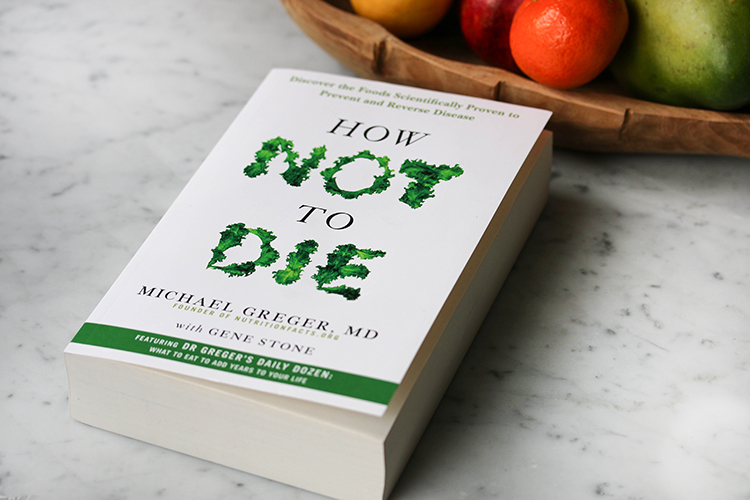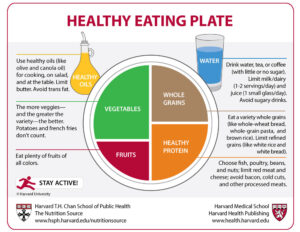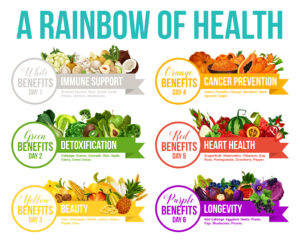Three things can rev up our health and energy engine: good nutrition, exercise, and sleep.

They may seem simple and obvious, but that doesn’t mean that they’re easy to implement consistently over time. Here, we focus on good nutrition for health and wellness.
The Problem of Poor Nutrition
Unfortunately, many people struggle with poor nutrition. The “standard American diet” as they call it is, well, SAD.
In his book, How Not to Die, esteemed American physician and author Dr. Michael Greger notes the following:
- “Our diet is the number-one cause of premature death and the number-one cause of disability.”
- “More than two-thirds of American adults are overweight.” (A healthy weight is important for heart health, blood pressure, cholesterol, avoiding diabetes, and more.)
- “We may be in the process of raising the first generation of children in America with a shorter predicted life span than their parents.”
“Health is not valued until sickness comes.”
-Thomas Fuller

Unfortunately, most of our calories come from unhealthy sources, and very few come from the healthiest sources (such as whole plant foods), according to the U.S. Department of Agriculture. See the chart below.

15 Benefits of Good Nutrition
Good nutrition comes with an incredible array of benefits. For example, it has positive effects on:
- energy
- growth
- repair
- heart health, including lower risk of heart disease (the top killer in the U.S. and around the world)
- immune function
- muscles
- bones, including lower risk of osteoporosis
- skin
- eyes
- teeth
- blood pressure
- cholesterol
- weight
- sexual function
- longevity
Good nutrition can also play a big role in prevention of diet-related illnesses, including some cancers and Type 2 diabetes, and avoidance of vitamin deficiencies, which can weaken parts of our immune system. And it affects not only our mood but also our mental capacity and stamina.
“The foods we eat affect us more than we realize…. Food has a direct impact on our cognitive performance.”
-Ron Friedman, “What You Eat Affects Your Productivity,” Harvard Business Review, October 17, 2014
With four healthy lifestyle factors (eating healthier, not being obese, exercising 30 minutes a day, and not smoking), we may reduce our risk of having a heart attack (our top killer) by more than 80%, reduce our risk of developing diabetes by more than 90%, cut by half our risk of having a stroke, and reduce our overall cancer risk by more than a third.*
“To eat is a necessity, but to eat intelligently is an art.”
-Francois de la Rochefoucauld, 17th century French author
What Constitutes Good Nutrition?
Many of us grew up learning about some form of food pyramid, a basic guide to healthy eating. A food pyramid was developed in Sweden in 1974, and in 1992 the U.S. Department of Agriculture developed its own “Food Guide Pyramid,” updated in 2005 (renamed “MyPyramid”) and then replaced in 2011 by “MyPlate.”
More recently, Harvard University researchers have developed the “Healthy Eating Plate,” a guide for creating a healthy and balanced diet. It offers updated and more specific and more accurate recommendations for following a healthy diet. It’s based on updated nutrition research, and it’s not influenced by the food industry or other special interest groups.
The Healthy Eating Plate recommends the following:
- “Make most of your meal vegetables and fruits – ½ of your plate. Aim for color and variety, and remember that potatoes don’t count as vegetables on the Healthy Eating Plate because of their negative impact on blood sugar.
- Go for whole grains – ¼ of your plate. Whole and intact grains—whole wheat, barley, wheat berries, quinoa, oats, brown rice, and foods made with them, such as whole wheat pasta—have a milder effect on blood sugar and insulin than white bread, white rice, and other refined grains.
- Protein power – ¼ of your plate. Fish, poultry, beans, and nuts are all healthy, versatile protein sources—they can be mixed into salads, and pair well with vegetables on a plate. Limit red meat, and avoid processed meats such as bacon and sausage.
- Healthy plant oils – in moderation. Choose healthy vegetable oils like olive, canola, soy, corn, sunflower, peanut, and others, and avoid partially hydrogenated oils, which contain unhealthy trans fats. Remember that low-fat does not mean ‘healthy.’
- Drink water, coffee, or tea. Skip sugary drinks, limit milk and dairy products to one to two servings per day, and limit juice to a small glass per day.
- Stay active. The red figure running across the Healthy Eating Plate’s placemat is a reminder that staying active is also important in weight control….
- The type of carbohydrate in the diet is more important than the amount of carbohydrate in the diet, because some sources of carbohydrate—like vegetables (other than potatoes), fruits, whole grains, and beans—are healthier than others.
- …avoid sugary beverages, a major source of calories—usually with little nutritional value….”
(Of course, not everyone agrees. For example, some people advise going oil-free, if possible, so they take issue with its mention of healthy plant oils, even in moderation.)

Tips for Good Nutrition
What can we do to eat better? So much! The Healthy Eating Plan is a great place to start—and even better when supported by additional tips and tactics addressing mindset, behavior, and habits. Here are dozens of things we can do to ensure we’re eating well:
- Eat more whole, plant-based foods, including more fruits, vegetables, whole grains, beans, and nuts
- Consume less processed foods (products created by the food industry with unhealthy artificial ingredients to extend shelf life and in some cases to become addictive)
- Eat less meats
- Consume more fiber (which helps with digestion and our microbiome, and makes us feel full so we stop eating)
- Shop for groceries intentionally
- Have more home-cooked meals, eating out and ordering takeout less often
- Plan and prepare healthy meals on a regular schedule (e.g., for the week)
- Limit portion size with smaller plates and other strategies
- Stop eating when full
- Eat more organic and locally sourced foods
- Consume a rich variety of foods—and shoot for all the natural colors (from white, green, and yellow to orange, red, and purple; see the “Rainbow of Health” image below)
- Make unhealthy foods inaccessible
- Minimize soda
- Reduce sugar
- Minimize salt
- Avoid or reduce junk food and eliminate it from the pantry
- Minimize saturated fat
- Avoid or reduce fast food
- Use less frying in preparing meals, with more grilling, roasting, braising, baking, stewing, broiling, and steaming
- Maintain regular mealtimes
- Eat slowly and mindfully while savoring the taste, texture, and experience
- Enjoy meals together as a family most days, if possible
- Pay attention to our body’s reaction to food during and after meals
- Drink water before meals
- Ensure proper hydration throughout the day**
- Impose a curfew on eating, including snacking, at a certain time in the evening
- Try time-restricted eating or intermittent fasting (ideally under medical supervision)
- Avoid binge and emotional eating and drinking
- Consume healthier caffeinated drinks (e.g., with green and black tea, not artificial ingredients)
- Check food labels and learn about natural versus artificial ingredients
- Track our food intake
- Experiment with vegetarian or vegan eating; start by replacing more and more of our plates with plant-based foods
“Eat food, not too much, mostly plants.”
-Michael Pollan, author and journalist

Top Strategies for Good Nutrition
The tips above will serve us better when supported by higher-level principles and strategies related to health and nutrition, including:
1. Develop a healthy mindset about food, with clarity about the benefits of good nutrition and a positive attitude, including a good balance between self-discipline, self-acceptance, and self-compassion. And don’t equate health with weight loss—or a healthy body with a skinny one.
“Your diet is a bank account. Good food choices are good investments.”
-Bethenny Frankel
2. Find out what works for you and do more of that. There’s no need to try all the tips above. Start with one or two and see what works and what doesn’t. Don’t let the perfect be the enemy of the good: don’t expect perfection and risk getting frustrated.
3. Replace bad habits with good ones. This comes with a double benefit of building momentum while reducing harm. For example, creatively sneak in more vegetables during meals (including at breakfast), and curb snack cravings with healthier options, including protein. Consuming a good variety of healthy foods every day leaves less room for foods that are processed and high in sugar.
4. Make healthy eating as easy as possible—not only by making healthy foods accessible and unhealthy foods inaccessible but also by building habits and routines out of healthy eating.
5. View health holistically. Consider not just good nutrition but also exercise and sleep (which we address in separate articles), and not just physical health but also mental and emotional health. Together, their effects compound, creating incredible value across all dimensions of our lives over time.
“Looking after my health today gives me a better hope for tomorrow.”
-Anne Wilson Schaef, clinical psychologist and author
Wishing you well with it!
–Gregg

Tools for You
- Traps Test (Common Traps of Living) to help you identify what’s getting in the way of your happiness and quality of life
- Quality of Life Assessment to help you discover your strongest areas and the areas that need work and then act accordingly
- Personal Values Exercise to help you clarify what’s most important to you
- Leadership Derailers Assessment to help you identify what’s inhibiting your leadership effectiveness
Related Articles
- “Health and Vitality: Keys to Your Quality of Life”
- “Exercise and Movement for Health, Wellness, and Great Work”
- “Great Sleep for Health, Wellness, and Great Work”
- “The Benefits of Nature and Getting Outside“
- “The Trap of Bad Habits—And How to Break Them”
- “Self-Care and Personal Resilience in Hard Times”
- “The Benefits of Systematic Personal Development”
- Ron Friedman, “What You Eat Affects Your Productivity,” Harvard Business Review, October 17, 2014
Related Resources
Books:
- Michael Greger, How Not to Die: Discover the Foods Scientifically Proven to Prevent and Reverse Disease (Flatiron Books, 2015)
- Michael Greger, How Not to Diet: The Groundbreaking Science of Healthy, Permanent Weight Loss (Flatiron Books, 2019)
- Shawn Stevenson, Sleep Smarter (Rodale, 2016)
Podcasts:
- “Feel Better, Live More” (Dr. Rangan Chatterjee)
- “Model Health Show” (Shawn Stevenson)
- “Nutrition Facts” (Dr. Michael Greger)
- “The Rich Roll Podcast” (Rich Roll)
Films:
- “The Game Changers” (Netflix)
- “Live to 100: Secrets of the Blue Zones” (Netflix, forthcoming)
Postscript: Inspirations on Healthy Food, Nutrition, and Eating
- “The greatest wealth is health.” -unknown
- “The first wealth is health.” -Ralph Waldo Emerson, American philosopher and essayist
- “It is health that is real wealth and not pieces of gold and silver.” -Mahatma Gandhi, Indian lawyer and transformational leader
- “He that takes medicine and neglects diet, wastes the skill of the physician.” -Chinese proverb
- “Let food be thy medicine, and let medicine be thy food.” -unknown (though often misattributed to Hippocrates)
- “The food you eat can be either the safest and most powerful form of medicine or the slowest form of poison.” -Ann Wigmore, Lithuanian–American holistic health practitioner, naturopath, and raw food advocate
- “Moderation. Small helpings. Sample a little bit of everything. These are the secrets of happiness and good health.” -Julia Child, American chef, author, and television personality
- “Any food that requires enhancing by the use of chemical substances should in no way be considered a food.” -John H. Tobe, researcher, naturalist, and author
- “Vitality and beauty are gifts of nature for those who live according to its laws.” -Leonardo da Vinci, Italian painter, scientist, sculptor, and architect
- “Time and health are two precious assets that we don’t recognize and appreciate until they have been depleted.” -Denis Waitley
- “Happiness lies first of all in health.” -George William Curtis
* Source: Dr. Michael Greger, How Not to Die (Flatiron Books, 2015).
**Water is the main component of our blood. It’s essential for carrying nutrients to our cells and eliminating waste products. We tend to feel fatigue when we’re dehydrated.
++++++++++++++++++++++++++++++
Gregg Vanourek is a writer, teacher, TEDx speaker, and coach on leadership and personal development. He is co-author of three books, including LIFE Entrepreneurs: Ordinary People Creating Extraordinary Lives (a manifesto for integrating our life and work with purpose, passion, and contribution) and Triple Crown Leadership: Building Excellent, Ethical, and Enduring Organizations (a winner of the International Book Awards). Check out his Best Articles or get his monthly newsletter. If you found value in this article, please forward it to a friend. Every little bit helps!





